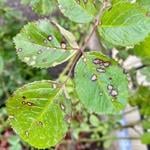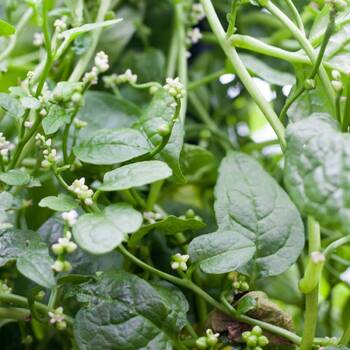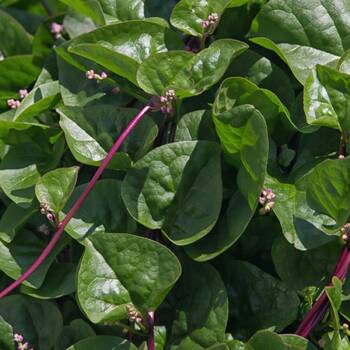
How to Grow Malabar Spinach Seeds
Grow Guide #2476
Family: Basellaceae
Binomial name: Basella sp.
Life Cycle: Perennial (grown as an annual in cool climates)
This 'How to Grow' guide details everything a home gardener needs to know to plant, grow and care for Malabar spinach (Basella sp.).
When to Sow Malabar spinach Seeds
Use the table below to identify the best time of year to sow Malabar spinach seeds in your climate.
| JAN | FEB | MAR | APR | MAY | JUN | JUL | AUG | SEP | OCT | NOV | DEC | |
|---|---|---|---|---|---|---|---|---|---|---|---|---|
| Cool | ||||||||||||
| Temperate | ||||||||||||
| Sub-Tropical | ||||||||||||
| Tropical | ||||||||||||
| Arid |
Preparation
Malabar spinach plants are best grown in full sun. Choose a location that will receive at least 6 hours of full sun each day.
Malabar spinach plants are perennial, meaning they live for several years. Choose a permanent position where plants can grow undisturbed by regular digging.
Malabar spinach plants need a well drained soil enriched with plenty of organic matter. Prepare soil by weeding it thoroughly, digging it over to loosen it and adding aged animal manure or compost. Keep the area free of weeds until planting. Learn more about preparing soil for planting here.
Malabar spinach plants can be grown in containers. If possible choose a variety that’s recommended for container growing. Use a good quality potting mix and make sure your container is large enough for mature plants; a minimum of 40 litres is recommended for Malabar spinach. During the growing season, keep in mind that container grown plants may need additional fertiliser to encourage healthy growth.
How to Sow Malabar spinach Seeds
Malabar spinach seeds do not require any treatment (eg soaking, stratification) before sowing.
Malabar spinach seeds grow best when they are sown directly into the garden.
- Sow seeds directly in the garden 10mm deep and 20cm apart.
- Keep soil moist but never wet or dry.
- Seeds should germinate in around 10-21 days at a soil temperature of 24-30°C.
- Young seedlings will need protection from pests, pets and weather until they are established.
Malabar spinach is a tender crop that’s sensitive to frost. Do not transplant seedlings or sow seeds outside until all danger of frost has passed.
Optional: In cool climates Malabar spinach seeds can be sown indoors 6 weeks before the last expected frost. Grow them in a warm position with plenty of natural light.
How to Grow Malabar spinach
Malabar spinach plants need regular watering during the growing season. Do not let soil dry out; keep soil evenly moist but not waterlogged. Water deeply in the early morning or late afternoon. Avoid watering the leaves of plants to avoid fungal diseases. Learn more about watering here.
If soil was well prepared no extra fertiliser should be necessary. In poor soil or to give your plants an extra boost, application of a high-nitrogen fertiliser or one formulated for leafy greens or herbs can be beneficial:
- Apply slow release fertiliser at the recommended rate when transplanting or when seedlings are 5-10cm tall.
- Apply liquid fertiliser at the recommended rate and frequency during the growing season.
Plants can sprawl along the ground or be grown up a trellis, wire fence or tripod. If growing on a support, plants will support themselves but they can also be tied gently using twine or plant ties. Make sure you have the support in place when you sow seed or transplant seedlings to avoid disturbing the plant's roots later.
Tip - Malabar spinach plants can be grown as annuals or perennials. In tropical and subtropical climates plants will grow year-round. In temperate and cool climates plants are usually grown as warm-season annuals. To grow plants as perennials in cool climates overwinter pots in a sheltered frost-free position, or take tip cuttings in late summer and grow them on indoors over winter to plant out in spring.
How to Harvest Malabar spinach
Malabar spinach should be ready to harvest in approximately 60-70 days.
Leaves are ready to harvest when the plant is established and leaves are large enough to eat, and can be harvested as needed. Harvest leaves by pinching off the leaves, leaving some on the plant for future growth. Malabar spinach is best eaten soon after harvest. Store leaves short term in a perforated plastic bag in the fridge. For longer term storage leaves can be blanched and then frozen.
Common Problems when Growing Malabar spinach
Like all plants, Malabar spinach is susceptible to some pests, diseases and other problems. Below is a list of the most common problems gardeners encounter when growing Malabar spinach plants:
 Aphids are small (2-4mm long) sap-sucking insects that congregate on the new shoots or the undersides of leaves. They can cause leaves to wilt or become discoloured, and also excrete honeydew which can attract ants and other insect pests. To manage aphids, remove them by spraying with a garden hose, apply a soap or alcohol spray, or encourage predatory insects to your garden. Read more about aphids here.
Aphids are small (2-4mm long) sap-sucking insects that congregate on the new shoots or the undersides of leaves. They can cause leaves to wilt or become discoloured, and also excrete honeydew which can attract ants and other insect pests. To manage aphids, remove them by spraying with a garden hose, apply a soap or alcohol spray, or encourage predatory insects to your garden. Read more about aphids here. Bacterial leaf spot is a disease that causes irregularly shaped brown spots on all above-ground parts of a plant. The spots at first appear to be wet but become dry and scab-like over time. Leaves and flowers can fall prematurely. Water plants at soil level (not on the leaves), dispose of fallen leaves and fruit and practice crop rotation.
Bacterial leaf spot is a disease that causes irregularly shaped brown spots on all above-ground parts of a plant. The spots at first appear to be wet but become dry and scab-like over time. Leaves and flowers can fall prematurely. Water plants at soil level (not on the leaves), dispose of fallen leaves and fruit and practice crop rotation.


.png)




